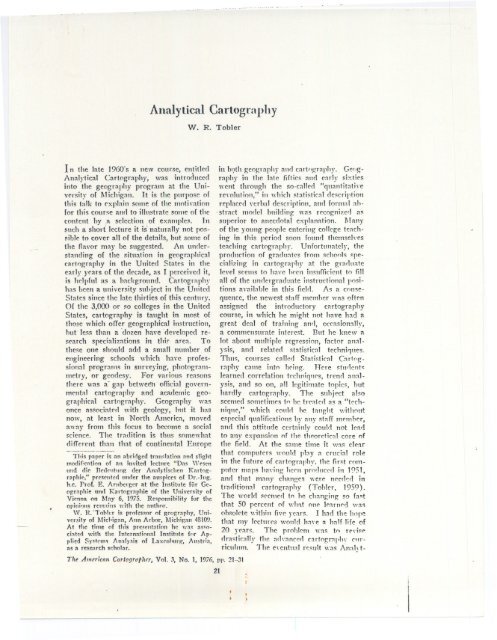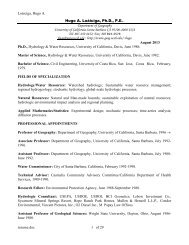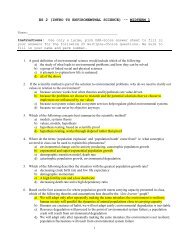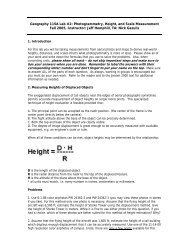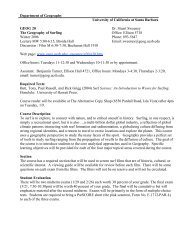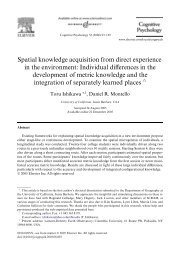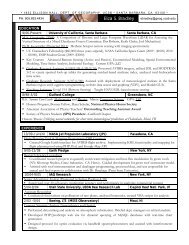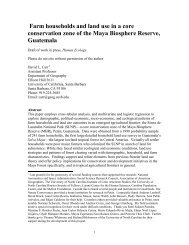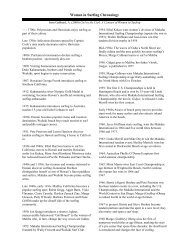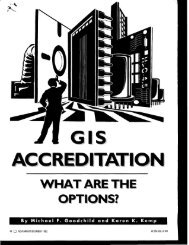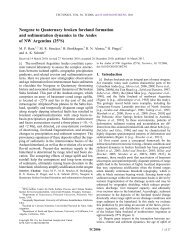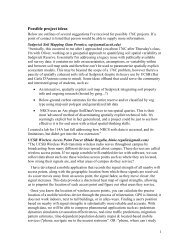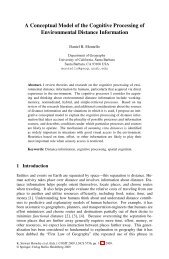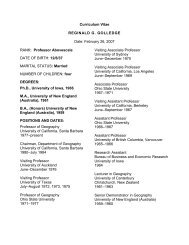Tobler 1976 - Department of Geography
Tobler 1976 - Department of Geography
Tobler 1976 - Department of Geography
Create successful ePaper yourself
Turn your PDF publications into a flip-book with our unique Google optimized e-Paper software.
... -<br />
Analytical Cartography<br />
W. R. <strong>Tobler</strong><br />
I n the late 19()()'s a new course, entitled<br />
Analytical Cartography, was introduced<br />
into tile geography pro~ram at the University<br />
<strong>of</strong> Michigan. It is the purpose <strong>of</strong><br />
this talk to explain sOllie<strong>of</strong> the motivation<br />
for this course and to iIIm;trate sOllie<strong>of</strong> the<br />
content lIy ,a selection <strong>of</strong> examples. In<br />
such a short lecture it is' naturally not possihle<br />
to cover all <strong>of</strong> the details, but sOllie<strong>of</strong><br />
the flavor may he suggested. An understanding<br />
<strong>of</strong> the situation in geographical<br />
C'arto~raphy in the United States in the<br />
early )'rars <strong>of</strong> the dC'cade,as I perceived it,<br />
is helpful as a background. Cartography<br />
has ken a university suhject in the United<br />
States since the late thirties <strong>of</strong> this century.<br />
Of the 3,000 or so colleges in the United<br />
States, cartography is taught in most <strong>of</strong><br />
th05e which <strong>of</strong>Ter geographical instruction,<br />
hut" less than a 'dozen have 'developed res('arch<br />
specializations in thif area. To<br />
these Ol1eshould add a small number <strong>of</strong><br />
engineering schools which have pr<strong>of</strong>essional<br />
programs in surveying, photograntt11('try,or<br />
geodesy. For various reasons<br />
there W:lSa- gap betwe(!h <strong>of</strong>ficial governmrntal<br />
cartography and academic geographical<br />
cartography. <strong>Geography</strong> was<br />
once as~ociat('cl with geology, hut it has<br />
now, at least in North America, moved<br />
away from this foclls to become a social<br />
science. The tradition is thus somewhat<br />
--------- dHTer('nt than that <strong>of</strong> continental Europe<br />
TI.is paper is an abridged tr:,"~I:ltion :md slight<br />
modifo(':ltion <strong>of</strong> :\11 invited Il'clllre "D:I~ "r I's('n<br />
\llId (tic Ikdrl1tllllf{ der An;ll}.tisc1len K:ltto~raphie,"<br />
rr('scnted tIIuler the al1~piccs <strong>of</strong> Dr.-Ing.<br />
h,c. Pr<strong>of</strong>. E. Amberger at the In~tilllle fiir Gc-<br />
(lr,mphie tlncl Kartogr;lphie <strong>of</strong> the Univer~ity <strong>of</strong><br />
Vienna
kal Cartography, as described in the<br />
conrse outline included here. Ollly minor<br />
modification <strong>of</strong> details has been required in<br />
the suhjed since 1969. It is perhaps also<br />
appropriate<br />
the contrast<br />
to draw especial attention to<br />
betwecn this direction <strong>of</strong> de-<br />
\'eIopment <strong>of</strong> the field <strong>of</strong> cartography with<br />
other de\'doping directions. l\fuch <strong>of</strong> the<br />
current literature, for example, emphasizes<br />
cartography as K~ographic illustration, in'<br />
which communication is paramount (Robillson<br />
aud Petchenik, 1975).<br />
A )lopular title would have heen Computer<br />
Cartography. This did not appeal<br />
to me because it is not particularly critical<br />
which productiou technology is used.<br />
Such a title would also imply the existence<br />
<strong>of</strong> other courses, perhaps titled Ilandicraft<br />
Cartography, or Pen and Ink Cartography.<br />
The substance is the theory which is more<br />
or less independent <strong>of</strong> the particular devices;<br />
equipment becomes obsolete rather<br />
quickly anyway. Mathematical Cartog-<br />
. raphy cuuld ha\'e been used for the title,<br />
bnt this already has a definite meaning<br />
(Graur, 1956; Solovye\', 1969), and I had<br />
in mind more than is usually covered under<br />
this heading. Ca'rtometry, the study<br />
<strong>of</strong> the accuracy <strong>of</strong> graphical methods, is<br />
another a\'ailable term, but has a rather<br />
narrow meaning. One could also speak <strong>of</strong><br />
Theoretical Cartography. This did not<br />
appeal to me on two grounds. It would<br />
frighten students, -\vho arc always concerned<br />
that they learn something practical.<br />
Secondly, the precedent is not very aUracti,'e.<br />
Max Eckert, for example, wrote a<br />
great deal about theoretical cartography<br />
hut did not sol\'e many prohlems (Eckert,<br />
I~21/25). I wished to emphasize that<br />
mathematical methods arc involved, but<br />
also that an objecti\'e is the s~lution <strong>of</strong><br />
concrete problems.<br />
As reKards the substance, rather than<br />
the conrse title, the major difference is<br />
perhaps only that a somewhat more general<br />
view is taken <strong>of</strong> the snhject. It is<br />
appropriate to introdnce stmknts to what<br />
is I aln:a(ly in the literatnre, to introcluce<br />
similar concepts which occur in other<br />
hranches <strong>of</strong> knowlt.:dKe,and to snggest new<br />
directions. Emharrassin~ly freqnently car-<br />
tographers claim as unique problems those<br />
which also occur in other fields anrl which<br />
may cven have Leen soh'cd there. All<br />
pr<strong>of</strong>essions rnust constantly fight their<br />
myopia. ..But clearly the application <strong>of</strong><br />
mathematical methods to cartography is<br />
growing rapidly. Thus a simple introduction<br />
to Analytical Cartography is through<br />
Photog-ranunetry aud Geodesy. These<br />
fields have a long mathematical traclition<br />
and a healthy literature to which the studcnt<br />
need only he referred. The principal<br />
equations <strong>of</strong> the method <strong>of</strong> least squares<br />
and its newer derivatives, <strong>of</strong> the theory uf<br />
errors, and some theorems <strong>of</strong> projective<br />
geometry and <strong>of</strong> potential theory, etc., are<br />
all easily reviewed. One can also see tendencies<br />
such as the direct production <strong>of</strong><br />
lIIosaics from aerial photographs and the<br />
computer recognition <strong>of</strong> ohjects seen hy an<br />
imaging system (Duda a111I lIart, 1973).<br />
Another trend is the replacement <strong>of</strong> triangulation<br />
by trilateration.<br />
To see how a more general view is useful,<br />
consider this last topic, in which one<br />
determines locations fro111measurements.<br />
Suppose that we have identified 11points<br />
on the surface <strong>of</strong> the earth. Between these<br />
there exist 11(11-1)/2 distallces, djJ, Let<br />
us assume that all <strong>of</strong> these distances have<br />
been measured and that the locations <strong>of</strong><br />
the points are to he found. This means<br />
that 2/1 coordinates lIlust be determined.<br />
In high school one learned that one could<br />
compute distances from coordinates hy use<br />
<strong>of</strong> the Euclitlean formula ,<br />
v(xl-xJf2t-h"-)'J)2 ~ dl,.<br />
The surveying prohlcm reverses the arro\\",<br />
and e\"cry surveyc,r knows how to find the<br />
coordinates when gh'en the distancl~s. In<br />
this problem the value <strong>of</strong> 11(/I-I) /2 grows<br />
much faster (essl.ntially quadratically)<br />
than docs 2/1 and there arc thus more<br />
equations than IInkno\\"ns. This has three<br />
useful consequences: (I) No solution satisfies<br />
all elJllation~, sinl'e all empirical<br />
measurements have error. This leacls natur:1l1y<br />
to a discussioll <strong>of</strong> I('ast $C111:IH'S<br />
1m.thocls,error ellipses, and iterative solution<br />
pmcedllres. nut one also ohtains intern:11chrd::;<br />
on the aCCllral'y<strong>of</strong> the meas-<br />
22<br />
TII.: Amuictlll<br />
Cnrl"yror/'f,cr<br />
-- ----
urcmcnts. (2) One only nced;; to know<br />
the ordinal relations <strong>of</strong> the uistances in<br />
oruer to obtain a solution (Shcpard,<br />
1966), which comes as quite a shock to the<br />
cartographer who strongly believes in<br />
numbcrs. (3) Only 2n measuremcnts are<br />
J"(.rtllyncces::ary, amI one is then led to<br />
consider thc "optimal" positioning <strong>of</strong> sllrnying<br />
measurements, a rather reccnt de-<br />
\'('Iopmcllt in thc literature (Grafarend and<br />
I JarlalHl, 1973). A cartographic application<br />
<strong>of</strong> this "gcodetic" techniquc might be<br />
:IS follows: Suppose one is successful in<br />
getting people to complete a questionnaire<br />
in which they are required to estimate the<br />
distallces bctween, say, prominent buildings<br />
in Vienna. The result <strong>of</strong> this cmpirical<br />
uperations yitlds data similar to the measuremcnts<br />
ohtained from a geodetic survey<br />
in that it is p05sillle to compntc coordinates<br />
ami their standard errors (Toiller, <strong>1976</strong>).<br />
One can thus obtain a type <strong>of</strong> mental map<br />
(Gonld and White, 1974) and its degree<br />
<strong>of</strong> variancc. Comparison with geodetic<br />
I,ositions enables one, using Tissot's Theorem,<br />
to measure the amount <strong>of</strong> distortion<br />
<strong>of</strong> thcse mental maps. Analyzing such<br />
data over time may reveal the rate <strong>of</strong> spatial<br />
learning. which is geographically a<br />
,'cry interesting question. A similar tcchnique,<br />
incidr-ntly: is uscd in psychology<br />
,\'Ilcn one attempts to portray separations<br />
hctwccn personality typcs. In some respects<br />
the psychology literature 011trilaterat<br />
ion, undcr anothcr name (Shepard,<br />
1962) is more ach'anced than the geodetic<br />
likrature.<br />
Two other examplcs <strong>of</strong> old topics in ncw<br />
guises stell1 irom thc suhject <strong>of</strong> map projections.<br />
In the 1880's Fra!lcis .Galton<br />
invcnt('d the geo~raphical isochrouc, a linc<br />
conmding all points which can he ft'acllcd<br />
in a givell time. Isochronic maps are no\v<br />
quitc popnlar, anet the concept has be~n<br />
g(~nerali7.l"(1to inclnde tnl\'cI costs (isotims).<br />
The,;~ arc really g('ographkal circles,<br />
recallin~ thaI a circle is thc lucus <strong>of</strong><br />
points e1lni,listant from a centcr point.<br />
Measure distance in units <strong>of</strong> time ali(I you<br />
have a gcd~ral'hical circk nut what curiollS<br />
circle!>. The}' havc hol('s in them,<br />
ali(I Ilisj(lint pieces, amI the ratio <strong>of</strong> cir-<br />
ClImference to radius is hardly 211". \Vhat<br />
a curious geomeh")'-it makes Eiustein<br />
seem simple! Or consider a set <strong>of</strong> concentric<br />
isochrones. Now draw in the or~<br />
thogonal trajectories and one ha$ the<br />
equivalent <strong>of</strong> a set <strong>of</strong> polar coordinates.<br />
Technically these arc the polar geodesic<br />
coordinates <strong>of</strong> Gauss, familiar from diffcrential<br />
geometry, and for which the metric<br />
takcs on a particularly simplc form. One<br />
can draw' maps <strong>of</strong> this geographical geometry<br />
b)' using the usual ideas from the<br />
study <strong>of</strong> map projections, but the rderencc<br />
object is no longer a sphere or 5pheroid,<br />
rather it is more like a pul!'-3ting Swiss<br />
cheese. As a second map projection example,<br />
COlisider the prol,km <strong>of</strong> didding<br />
the Uniteu States into compact cells, each<br />
<strong>of</strong> which contains the same number <strong>of</strong> people,<br />
and how it might be approached hy a<br />
map projection. Figure I shows how delibcrate<br />
distortion can be used to advantage<br />
in solving this practical problem. The differential<br />
eqllations covering this situation<br />
have been published elscwhere (Toblt:r,<br />
1973). .<br />
Computer graphics are introduced in the<br />
sccond week <strong>of</strong> the course. One kIlO\\'S,a<br />
priori, that all maps which can be drawn<br />
by hand can also he drawn hy computercontrolled<br />
dc\.ices. This follows fwm<br />
Turing's (19.36) theorem. Of course WII<br />
docs not imply sl/Ol/ltl. Stmlents are given<br />
a short introdudion to the equipmcnt<br />
which proddes a realization <strong>of</strong> these ideas<br />
and to the sources from which they can obtain<br />
geographical data tapes and computer<br />
programs. Examples arc run using the<br />
data and eqllipment a\'ailahle in the local'<br />
environnH:nL The data tapes include<br />
world outlines, couuty houndaries, street<br />
patterns, census tal/l1lations, topographic<br />
elevations, clc. Equipmcllt facilities at the<br />
Ulli\'(~rsit}' <strong>of</strong> Michigan include a large<br />
computer connccted to telcphones amI teletype<br />
h~rminal:;, or graphic dnices call tie<br />
attachcd to any user telepholll: for interacth'e<br />
use. The s}'stem is outstall(ling' in its<br />
ease <strong>of</strong> access for novices. Students write<br />
olle program to draw a simple map <strong>of</strong> their<br />
chnic,: in one <strong>of</strong> the l)I"o.~rammil1glanguages.<br />
2.1
.:J;.",~'<br />
:: t~~;<br />
~}..<br />
.-< fill<br />
tpulation<br />
('In each <strong>of</strong> th~ two maps. The computation proceeds from top Il'ft to tnp richt, then to hottorn<br />
right to hottorn left. The pictures in the middle row serve as illustrO\tionsand have no computational<br />
significO\nce. After Tohlcr, 1973.<br />
The user <strong>of</strong> geographical data is, in principle,<br />
indifferent as to whether the data are<br />
on a geographical nmp or on magnetic<br />
tape. One <strong>of</strong> the principal uses <strong>of</strong> geographical<br />
maps is that <strong>of</strong> a graphical data<br />
stor;'lge de\"ice. But tapes are <strong>of</strong>ten more<br />
cOJ1\'enient than are drawings. These arc<br />
simply two alternate methods <strong>of</strong> storing<br />
geographical information. \Ve can assert<br />
tlmt, when one has enough information on<br />
a magnetic tape to be able to draw a geogr;:..phicalnmp,<br />
one also has enollgh information<br />
on the tape to he able to soh'e all<br />
<strong>of</strong> the problems which could be solved using<br />
that map. But to store geClgraphical<br />
24<br />
information in clectrCIl1icform in such a<br />
manner that a gcographical map can be<br />
drawn reqllires that the sul151anlh-e data<br />
he gh'en geographical refercncing. The<br />
usual procedure is to reference poinl--, lin'.:s<br />
and areas by coordinatrs: geodetic lalitmle<br />
and longitude, or Gauss-Kruger cOClrdinates,<br />
etc. (1\[aling, 19i3). So thrse must<br />
be treated in the analytical cartography<br />
course. Bllt this is really too narrow a<br />
point <strong>of</strong> view. Can the fire department<br />
al1fl annollnce that there is a fire in thi"<br />
room, at 4S"15'22"N, 1(;o2.rJO"E. It<br />
would nen'r be rlone; one ",ollM me Ihe<br />
street adrIrcsi: or the building name. But<br />
TI,t Alllrr;roll C(l~'''!lrIt/'''tr<br />
- - --
-<br />
there arc 110cartography hooks which descrilJe<br />
the street lIaming/numbering system.<br />
If I can locate a house using the<br />
street address then this label must contain<br />
exactly the same amount <strong>of</strong> information :is<br />
doC'!; thr. laliturlej10ngitudc designation<br />
(IInffmali, 1952). The telephone area<br />
code number for '"ienna, 0222, locates this<br />
place to circa :1:20km. If I call from the<br />
United States to a phone in Vicnna, I lIeed<br />
to dial 12 digits, and these digits locate an<br />
area lIot much bigger than I sq. m. If I<br />
know the postal code for Laxenburg, 2361,<br />
thcn I have specified a region to :1:5km.<br />
Equivalentl}', Gauss-Kruger coordinates<br />
can be calculated from latitude and longitude<br />
p,A-+ G,K and this is invertible<br />
G,K -+ t',A. l\[ake a list <strong>of</strong> as many ways<br />
as you can recall <strong>of</strong> how locations are identified.<br />
Some will define points, others will<br />
refer to regions (\Verner, 197"; Clayton,<br />
1971). Now form a table by repeati ng<br />
this list in the orthogonal direction and<br />
consider this tahle as a transformer; place<br />
name to latitude amI longitude, and the inverse,<br />
might he an example <strong>of</strong> two transformations.<br />
The concern in the literature<br />
with computerized address. coding, ,the<br />
DIME system (Corbett, 1973), point-inpolygon<br />
programs, etc., al1 relate to these<br />
transformations (Barraclough, 1971).<br />
fllore exactly considered, coordinates are a<br />
way <strong>of</strong> naming places which, inter alia,<br />
allow all places to he given a unique name,<br />
and which allow relations between places<br />
to be deduced from their names. The<br />
North Amerkan telephone area codes, for<br />
example, ha'"e the property that if two area<br />
codes are similar, the places, are most likely<br />
widel}' separatell, and the converse. TillIS<br />
the telephone area code scheme implicitly<br />
inchllles a relation between the places.<br />
From this n.:1ation one can use the trilateration<br />
proce(lure, already descrihed ahove,<br />
to compute allll draw a map <strong>of</strong> North<br />
America. In order to do this simply use<br />
the implicit relation and then inl
,,'1'.1111 .All h' '( IiIlUIl 'tI.'rt,..'.. II';<br />
. .,' ;~.<br />
A'ICIIICAN D!SCkl8!D IV ~.o rOIN'S<br />
MICIIIC>N DISCkl!!D AV 15' rOINlS<br />
Fig. 2. Sill1l'lific.1.tion <strong>of</strong> a polygonalstructure b)' a cOlllputeralgorithm.<br />
lIot <strong>of</strong> a numerical naturc (Guptill, 1975). fcld, 1969; Andrews, 1970; Codd, 19(8).<br />
Pedagogically it seems Iu:'st to introdllcc J]erc onc has data at c\'cnly-spaccll spatial<br />
stlldcnts to thesc mcthods II)' collsiderillg intervals, and l1Iany important cOllccpls<br />
the fi(.\.i <strong>of</strong> "pictllre proccssin~" (Roscn- can he cxplain~d most easily in this spa-<br />
201 TIll A "'.-r;((11~l aTlo[/rat/...,<br />
-- ---
. .<br />
Fig. 3, Simplification <strong>of</strong> a topographic surface by spatial filtering. Aftl,.. ToLler, 196;.<br />
tiall}' homogeneous environment. The notions<br />
can thf:n later be generalized to include<br />
the more practical case in which the<br />
data arrive packaged in irregular spatial<br />
polygons or at random point sets, But a<br />
critical lack here is a useful model <strong>of</strong> the<br />
functioning <strong>of</strong> the humilll brain (hut see<br />
Arbib, 1972; Stockham, 1972). The design<br />
<strong>of</strong> maps cannot be imprO\'ed without<br />
such a standard against which to test visual<br />
cfTecti\'eness.<br />
As a simple example <strong>of</strong> a problem in the<br />
processing <strong>of</strong> geographical data, one can<br />
take the case <strong>of</strong> map overlays, e,g., given a<br />
soils map <strong>of</strong> Michigan and a geological<br />
iliaI' (Jr ~Iichigan, find the logical intersection<br />
<strong>of</strong> the two. Conceptuall)' this is not a<br />
difficult prohlem, and' it can he done usin~<br />
a computer, as is illustrated in Fig. 5.<br />
One has se\'eral choices in the way in<br />
whidl the reg-ions are stored in the compnter.<br />
These options become quite technical,<br />
Illlt, for exalllple, an area can be described<br />
(l\lehzer, Searle, and Drowu,<br />
19(7) as<br />
F<br />
'(.¥',y) =<br />
}<br />
1 if in R<br />
0 otherwise,<br />
or, the houndar)' can IJe 11('scrihell as an<br />
eCluatioll x(J) -I-iy(s) = :;(s), or one can<br />
store the skeleton (BlUIII, 19(7) <strong>of</strong> the<br />
fI'gion. From all <strong>of</strong> thesc f('presentations<br />
V,,1.3, ,\'(1. I, A/,ril]9i6<br />
(and there are morc), olle can compute the<br />
area <strong>of</strong> a region, calculate whether or not<br />
a point lies inside <strong>of</strong> the region, find<br />
whether two regions overlap, and draw<br />
maps. It turns out, howe\'er, that some<br />
representations are 'more convenient for<br />
particular purposes thau art! others, e\'en<br />
though they are algebraically equivalent in<br />
the sense that earh can be cOll\'erted into<br />
all <strong>of</strong> the others (Palmer, 1975). r\ comparison<br />
to two methods <strong>of</strong> soh-ing a pair uf<br />
simultaneous linear equations may he appropriate.<br />
If one rememhers a bit <strong>of</strong> algebra<br />
and that linear e'l\lations ha\'e the<br />
form<br />
J'l=At+JltX<br />
Y2 =A~ + /I,X.<br />
then the intcrsedion point can he flHlIId hy<br />
the simultaneons solutiou or these eClnations.<br />
But sometimes it is easier to plot<br />
the lines and to rearl the ('oonlinates <strong>of</strong> the<br />
intersedinn from the drawing. Man)'<br />
, uses <strong>of</strong> maps arc <strong>of</strong> this n()l11o~raphic nature.<br />
Recall that r...Tcrcator's projection,<br />
for example, prm'ides a ~raphil: solntion to<br />
the prohk-m <strong>of</strong> finding- the inl('rsl:ction angle<br />
behn'ell a North-Sonth gr('at circle ancl<br />
a logarithmic spiral 011a splll."n:. Or consider<br />
the prohll'1Il <strong>of</strong> finding the nl'are5t<br />
station wlll'n the automohile ~;\IIg-c indi.<br />
cates "nearly empty." \\'ith the entire<br />
f::a-;<br />
27<br />
- ------- --- --
.<br />
:~~~~~~~~~~~-~~<br />
mmm::: ::<br />
:: 1::::::::: :: I<br />
-00-- HHimnn i1<br />
'1.' .. ::::::::::::::<br />
"<br />
" .::::::, . I. :::::::::::::: s<br />
II .1&. : .<br />
.;;:::::::; I' H! :i:::!::::::: I<br />
.. 11 111,1 111h..h .. I<br />
illlllllllllllllllllllllttttttltlll!III;IIIIIIIIII~1<br />
,:...:.,.: it --<br />
i;EiiEiEEEi!i!!!!:ii~~~~EEEiii!ii:!!!:ii :..! l .:iiiiiiiiii i3<br />
I:!i.!i;iiii!:iiiiii~E~:!:i!!!i!!ili:!I!ii!!iEl!!!ii<br />
: ' !'.. , .. !.<br />
...................--...............................<br />
!i:!:!!:::::!::::::::;!:I::::::!:::,:::::::::::::::<br />
I<br />
li::::::;:::::::::::::I::::!:51511::::::::::::::::::<br />
'.!i::i::::;I:::::::::::::!:!:i::<br />
I:;:::::::::::::::<br />
I<br />
1::::::!!!:!I!::::!::::!!!:::::!!!:!'::i!!!:::!::::! 1<br />
I'<br />
::::::::::::::::!::::::::::::::::I!:!::::::::::::::: I<br />
!:.: : :...:I :...::: I ,~<br />
I<br />
i~~~i~i~iiiiii~ii~i¥~~~~!i~~ii~~i!!!!iiiiiii~~ii~iii I ~<br />
'..::I;:liiill:I:;:;:;:;::'!::::::,::::I:::::::;i:: 1<br />
I<br />
':!!I'.<br />
I::!Eij:i:EEiii!iii!ii:!!i!!ii!!iii:!E! 1<br />
...1 :hi : , I_ ti<br />
I<br />
. .. .i;!!I:il~~~!E~~iii!!!!!!iii!i§!iii!iii!iii ...:.. 1.: !~<br />
iii::::::::.<br />
.:::..:::: II II:::::::;:::::::::::::~~::::::::::: : , f-<<br />
1"." :<br />
I<br />
.. ":!I.f:i::::::::::::::;:;:::::~;;:;;.<br />
"'i I ... b<br />
I I<br />
-......<br />
1<br />
1 __<br />
I<br />
I"<br />
~<br />
' i~;~iii!E;ffIJIlii~iisiiiiii!iS!Ei5!ii~§~~~~<br />
, ! I,.1 I.; - ,<br />
I ::::::::: ' ...:::::::::::::.:.:::::::~~- I L~<br />
,<br />
i .l. j<br />
. "'"<br />
, 1<br />
'II 1-"<br />
I j ." y<br />
1 ''' 1 ' j r<br />
,'r-<br />
I , "1. "1<br />
1<br />
'/1" ' II, :::::::::::' , ,: ..<br />
OJ<br />
11<br />
! ,jilP;I,ipijiiili "<br />
'1: 1<br />
p:::::::" l.g<br />
! ili l ll!,II IIP,; !<br />
.' I "I .lfo! 'I -<br />
I ' .:!.: , ..II,,jll: !<br />
I ,II I .!!<br />
, i.lfl!! !l1I1.1i1 I : ...<br />
I .I.~... ..t. . [<br />
. ! IIJ<br />
4_______________________________________________________.<br />
.<br />
I<br />
>.<br />
.t:J<br />
.<br />
.<br />
.<br />
,<br />
.'<br />
. The Am,'ricall Carlo[1rd/'T,er<br />
28
Filt. S. Computcr;,:cd complltation <strong>of</strong> the logkal product <strong>of</strong> two maps. Left map: Soils ~ccording<br />
to the National Atlas or. the United States. Middle: Geolog}' fro 111the same source. Right: the<br />
10J:kal product.<br />
51reet system stored in the core or a pocket<br />
calculator, and the Jocation or alt the gas<br />
stations which accept my credit card aJso<br />
stored, and with a minimal path algorithm<br />
(Gitsitin and Wit7.galt, 1973) which is<br />
efficient for networks <strong>of</strong> this si7.e, it seems<br />
. like a trivial computation.<br />
'Vhat is easy, convenient, or difficult depends<br />
on the technology, ..circnmstanccs,<br />
and problem. The teaching <strong>of</strong> cartography<br />
must reflect this dynamism, and the<br />
student can only remain flexible if he has<br />
command or a theoretical structure as wen<br />
as specific implemcntations. The spirit or<br />
Analytical Cartography is to try to capture<br />
this theory, in anticipation or the man)'<br />
technological innovations which can be expected<br />
in the future; wrist watch latitude/<br />
longitude indicators, for example, and<br />
pocket calculators with maps displayen by<br />
colored light emitting diodes, do not seem<br />
impossible. In a university em'ironment<br />
one should not spcnd too much lime in (Iescribing<br />
how things are being done today.<br />
Thc course outlinc presented here tries to<br />
avoid this bias.<br />
COURSE<br />
OUTLINE<br />
Alltll:rlical Cartogra!>!I)', Gcography 482. 3 credits. Pro£. Waldo R. Tohlrr<br />
University <strong>of</strong> Michigan, Ann Arbor, Michigan 48109, U.S.A.<br />
IV uk 1. l"troduction. Relallon to mathcmatical geography, !:,eoclesy, photograllllnrtry, remote $.('nsing.<br />
Rrf'lacemrnt <strong>of</strong> map data storage by computcr data stor:\ge. Trchllolojtkal c11:1l1lte:mtl the<br />
ncr,l for' theoreticat a('proadl. Historical perspective.<br />
IV uk 11. CoI/Ip,",r Graplrir,f. Turing's theorrm in relation to carto!:,r:\phy. Olltpllt ,Iedcrs: lines,<br />
hal£tonc$., color. Sources <strong>of</strong> projtrams and algorithms. Dynamic cartography and compllll'r movie<br />
making. Jnteracth'e graphics in cartogra/>hy and geography.<br />
IV uk 111. Gcograpltical Ala/rice.f. Triagollal, quadrilat!'ral, hexagonal, and Escher typ!'5. Nulation,<br />
neighborliness prop!'rtr, topological invariance. Thc 'Varieties <strong>of</strong> (!el'grcra'or.f. Fuuction5 <strong>of</strong> lIIatrices: alnc'braic, logical, clifTer(,,\1liahlr,<br />
in\'l'rlil.~: linrar, I.)cal. $.I'atiall)' invariant (translationallr :lIId 1"{IIationall)'). 1':lralld I'rnl'.,ssin~.<br />
win.low$.. ecl~e eITeets. Finitc difference calcnlations.<br />
Jr (. ,f'. !~t'.r"(I)I,tI'F""rti"",f. Fourier :lIId other orlh..~on:tl $.frit.s. Operalic-lIs in Ihe fre'ln("/1f:y<br />
.lol1lain. T\\t., .Iim.,nsimml tnllls£.)rIll5.<br />
H',',(. 1'1. 'w,tli,,!1IJ11.l Ur.fol,,/ion. Fourier int('rJ!rC'lalion~ <strong>of</strong> alia5in~. t.all,llimih.,1 fIl11l'Ii""5, Ny-<br />
Itui-t limit, ('I)"''' functions. The salnl,ling theorem, n""loIII 1,1:l\Ic~a"'I.'i\1l:', ill\'i.il.l~ .li'fril."liolls.<br />
vl.r. -'. "'-0. I, At,.il 19;6 29
'11uk 1111. OI/CI,,';so,inn allJ Codillg. AII:llo!:lIe :\11
Goulrl, 1'. IInd R. White (1974), Mell/at Mn/'.f, Solo\"ye\', U. (1969), Mn/rmnlirl,r.n"nrcd hy<br />
The Lihrar)' <strong>of</strong> Congre;


